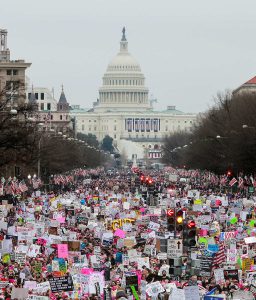(たぶん)凍える寒さの中でのものすごい人の波。期せずして自分たちがやってしまったことへの
ショックもあるかもしれない。Establishmentsであることを自覚しようとしなかったことを反省し
ているのだろうか?もしかしたらこの人たちがアメリカの分断とこの結果を招いたのかもしれない。
この「パラドックス」を考えるこの頃。
でも、正しいことは言うしかない。取り返しがつかないほど遅くなる前に!
(Good will win in the end. Madonna)
(ハフィントンポストのサイトからお借りしました) Photograph by Oliver Contreras/The Washington Post via Getty Images
A crowd fills the streets near Capitol Hill during the Women’s March on Washington.
The Future of the Left Is Female
Women’s rights are human rights, and women leaders are progressive leaders.
By REBECCA TRAISTER
A lot of people predicted that women were going to change America’s political history in January of 2017. But pretty much no one anticipated that they’d be doing it as leaders of the resistance. On Saturday, millions of women and men — organized largely by young women of color — staged the largest one-day demonstration in political history, a show of international solidarity that let the world know that women will be heading up the opposition to Donald Trump and the white patriarchal order he represents. Women — and again, especially women of color, always progressivism’s most reliable and least recognized warriors, the women who did the most to stop the rise of Trump — were the ones taking progressive politics into the future.
The Women’s March, dreamed up by a couple of women with no organizing experience in the feverish, grief-addled hours after Trump’s victory over Hillary Clinton, and then organized by an expanded team in the span of about ten weeks, was an earth-shaking triumph.
According to early reports, it drew somewhere north of 680,000 to Washington, D.C., 750,000 to Los Angeles, 400,000 to New York City, 250,000 to Chicago, 100,000 each to Seattle, Denver, San Francisco, the Twin Cities, and Portland Oregon; and crowds of thousands to smaller cities, including 11,000 to Ann Arbor, 5,000 to Lexington, Kentucky, 8,000 to Honolulu, and 20,000 to Houston. There were 2,000 protesters in Anchorage, Alaska, and 1,000 in Jackson, Mississippi. Demonstrations took place on all seven continents, including Antarctica.
This mass turnout in support of liberty, sorority, and equality was conceived by women, led by women, and staged in the name of women. It also drew millions of men. It was a forceful pushback to the notion that because a woman just lost the American presidency, women should not be leading the politics of the left. Women, everyone saw on Saturday, are already leading the left, reframing what has historically been understood as the women’s movement as the face and body and energy of what is now the Resistance.
Plenty of factors made this effort so successful, but perhaps the biggest was the shock and horror that jolted portions of a long-complacent population awake after the election of Donald Trump. As it turns out, sometimes, It Takes a Villain. We’ve got one now; he lives in the White House, has the nuclear codes, and spent Saturday defending the size of his, er, inauguration crowds. In his first weeks in office, he might very well nominate an anti-choice Supreme Court nominee, begin deportations, repeal health-care reform, start the process of withdrawing from the Paris climate accord, and defund Planned Parenthood. He has already reinstated the Global Gag Rule.
Yes, Trump exposed himself as a villain long before the election, and for many on the day of the march, the question was: Where was this energy before November 8? Clearly, the vast majority of Saturday’s crowd had been Hillary Clinton supporters, at the very least in the general election if not in the primary. But it is also true that some of the apathy, some of the complacency, that many critics took as a reflection of Clinton’s “flawed” candidacy stemmed instead from the sense that Americans didn’t really need to panic or take to the streets on her behalf because she was going to win. She was going to win, the assumption went, because of course we are evolved enough that this guy could never get elected president and thus we were free to focus on the imperfections of the woman who was going to be the president.
Through this lens, those who had been out there before the election, wearing T-shirts, holding signs, and talking passionately about the sexism Clinton was facing or racist backlash toward Obama or the high stakes of this election for women and people of color were silly bed-wetters, Hill-bots, embarrassing in their fixations on “identity politics.” Those yelling about sexism were playing some dated “woman card”; those trying to explain how gender and race and class intersect were jargon-happy hysterics. There was a confidence that the country’s problems with women had been largely redressed, or at least were no longer so entrenched that we would have to put in extra work on behalf of the first one to be running for the White House. But that confidence was baseless, ahistorical. The country has a yuge problem with women, and Donald Trump is the cartoonish embodiment of that problem.
Perhaps most surprising of all, men showed up alongside the women to fight for those rights. Many reports had the New York march at about half men, though some of that could perhaps be explained by the number of New York women who went to Washington alone, leaving kids behind with male partners. But those men — including my husband, including my male friends — brought those kids, girls and boys, to the march for women’s rights in New York. Men were at all the demonstrations in great numbers. They held signs like “I’m with her” with arrows pointing every which way; they chanted “her body, her choice”; one image shows a white guy holding a sign reading, “‘Screw it. I’ll do it.’ — Black Women *Thank You*” — a rare acknowledgment of black women as the most reliable progressives and left activists in this country. On the train returning to New York from D.C., I was wondering aloud to my editor whether people would continue to wear the pussy hats after the march. A bearded, gray-haired man piped up. “I think they’ll turn out to be a symbol of the new movement,” he said. “I’ll wear mine.”

